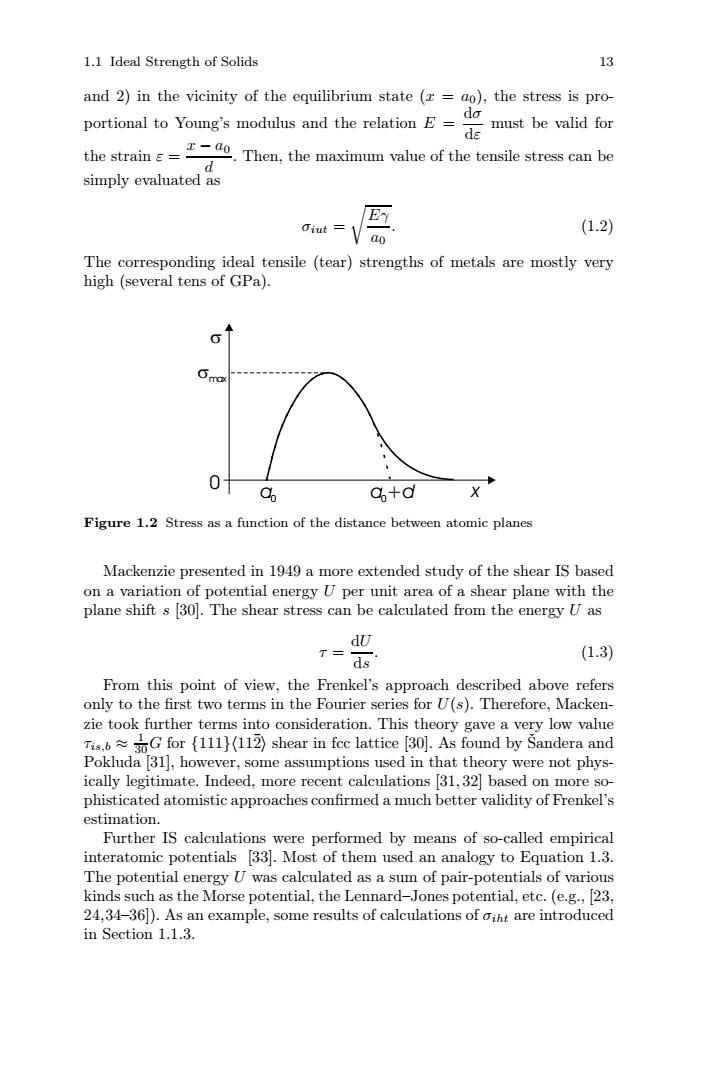正在加载图片...

1.1 Ideal Strength of Solids 13 and 2)in the vicinity of the equilibrium state (x =ao),the stress is pro- do portional to Young's modulus and the relation E de must be valid for the strain e o.Then,the maximum value of the tensile stress can be d simply evaluated as E (1.2) ao The corresponding ideal tensile (tear)strengths of metals are mostly very high(several tens of GPa). 0 a6 &+d X Figure 1.2 Stress as a function of the distance between atomic planes Mackenzie presented in 1949 a more extended study of the shear IS based on a variation of potential energy U per unit area of a shear plane with the plane shift s [30].The shear stress can be calculated from the energy U as dU T= (1.3) ds From this point of view,the Frenkel's approach described above refers only to the first two terms in the Fourier series for U(s).Therefore,Macken- zie took further terms into consideration.This theory gave a very low value sG for {111)(112)shear in fcc lattice [30].As found by Sandera and Pokluda [31],however,some assumptions used in that theory were not phys- ically legitimate.Indeed,more recent calculations 31,32 based on more so- phisticated atomistic approaches confirmed a much better validity of Frenkel's estimation. Further IS calculations were performed by means of so-called empirical interatomic potentials [33].Most of them used an analogy to Equation 1.3. The potential energy U was calculated as a sum of pair-potentials of various kinds such as the Morse potential,the Lennard-Jones potential,etc.(e.g.,23, 24,34-361).As an example,some results of calculations of oiht are introduced in Section 1.1.3.1.1 Ideal Strength of Solids 13 and 2) in the vicinity of the equilibrium state (x = a0), the stress is proportional to Young’s modulus and the relation E = dσ dε must be valid for the strain ε = x − a0 d . Then, the maximum value of the tensile stress can be simply evaluated as σiut = Eγ a0 . (1.2) The corresponding ideal tensile (tear) strengths of metals are mostly very high (several tens of GPa). a0 x 0 max a0+d Figure 1.2 Stress as a function of the distance between atomic planes Mackenzie presented in 1949 a more extended study of the shear IS based on a variation of potential energy U per unit area of a shear plane with the plane shift s [30]. The shear stress can be calculated from the energy U as τ = dU ds . (1.3) From this point of view, the Frenkel’s approach described above refers only to the first two terms in the Fourier series for U(s). Therefore, Mackenzie took further terms into consideration. This theory gave a very low value τis,b ≈ 1 30G for {111}11¯2 shear in fcc lattice [30]. As found by Sandera and ˇ Pokluda [31], however, some assumptions used in that theory were not physically legitimate. Indeed, more recent calculations [31, 32] based on more sophisticated atomistic approaches confirmed a much better validity of Frenkel’s estimation. Further IS calculations were performed by means of so-called empirical interatomic potentials [33]. Most of them used an analogy to Equation 1.3. The potential energy U was calculated as a sum of pair-potentials of various kinds such as the Morse potential, the Lennard–Jones potential, etc. (e.g., [23, 24,34–36]). As an example, some results of calculations of σiht are introduced in Section 1.1.3.���